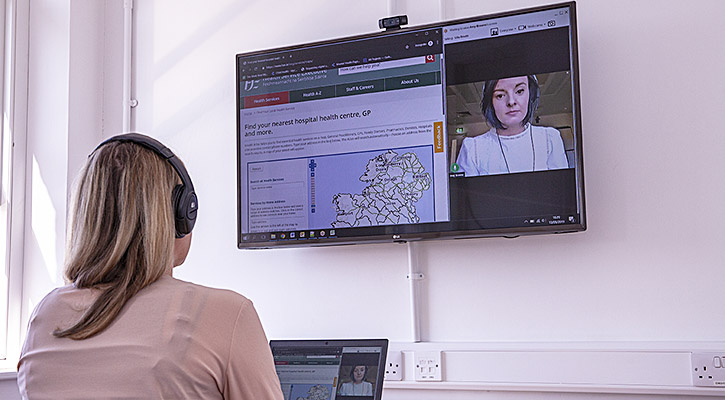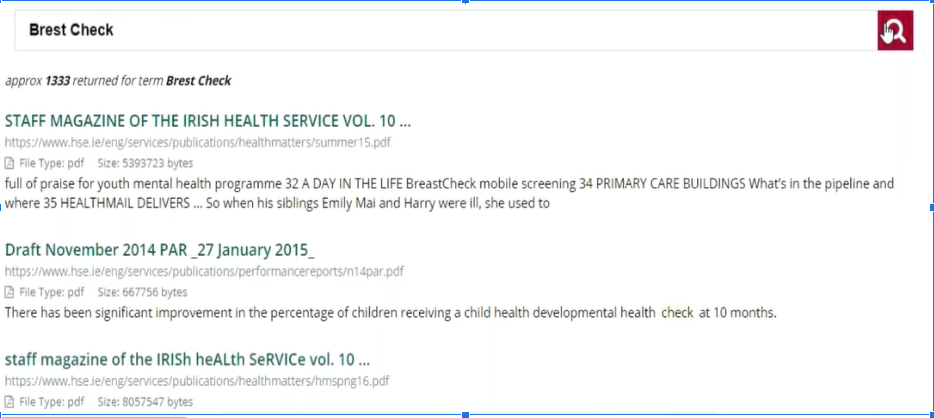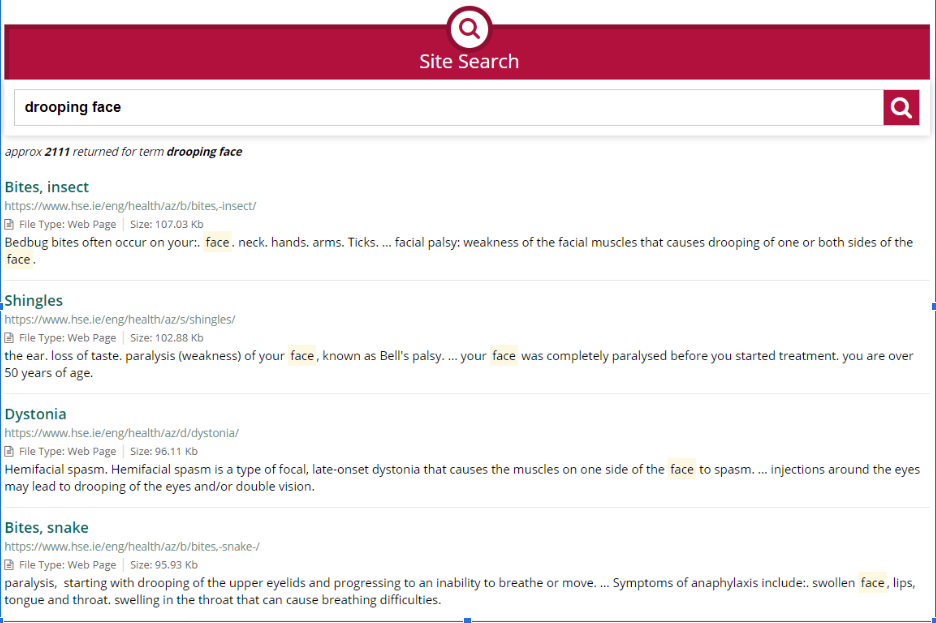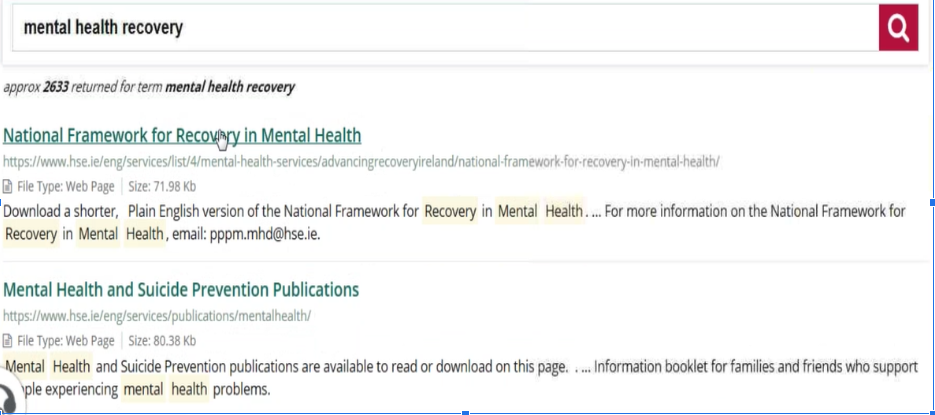Ulla Devitt and Amy Browne - User Experience

Above: Ulla (left) and Amy (right) demonstrate how they conduct remote online usability testing on HSE.ie with users. Photo: Andy Osborn
The results of our top tasks research told us what’s most important to people in Ireland in dealing with their health. The data from this research has informed the structure and content strategy of our new website.
We’re currently in the process of preparing new content and migrating from multiple old separate websites to the new HSE.ie which focuses exclusively on the online needs of the public. This site will help people to access information about HSE services and get answers to questions about health and wellbeing. Content for health service staff and other professional audiences will be published to a separate website, in line with the HSE digital roadmap.
To give us a baseline we can measure our progress against, and ensure our new website is an improvement, we use a process called Task Performance Indicator (TPI). This is a type of usability testing that shows us how well (or not) our website is working for people.
The results of the testing show us how many people were successful in completing the tasks we asked them to do (success rate) and also how long it took them to complete the tasks (time on task). Our goal is to make it as quick and easy as possible for people to get the information they need.

Above: Left - the old HSE website created for all content and all audiences - the general public, health service staff and other professional stakeholders with corporate updates and documents; Right - the new HSE website, dedicated to the online needs of the general public. Both are still in use until we fully migrate over to the new website.
Our first Task Performance Indicator (TPI) session
We recently did TPI testing for the first time on the old HSE.ie. This involved asking 16 users of HSE.ie to perform 11 tasks on our website while we observed their behaviour.
For example, we asked users to do things like:
- Locate the page where women can find out if they are registered for breast cancer screening.
- Find information that explains what symptoms such as difficulty speaking, moving arms and face drooping, is a sign of.
- Find the right place to go for treatment if a 3-year-old child living in Clare has sprained their ankle.
We then assessed how effective the website was in helping users complete these tasks.
How we ran the tests
We recruited participants through HSE.ie and developed a list of candidates across a mixed demographic. We then emailed test participants explaining what the test would involve, asking them to select a time slot for testing.
These tests were done remotely so participants were invited to an online meeting where they would share their screen with us. Each session lasted about one hour and was recorded so we could analyse it afterwards. We got consent from participants at the beginning of the session.
First, we introduced ourselves to the participant and briefly explained what the session would involve. The participant was assured that we were measuring the performance of the website, not them.
For each of the 11 tasks, the participants began on the homepage of HSE.ie. We gave them each task, one by one, and asked users to complete them as best they could. Participants did not need to think out loud or tell the facilitator what they were doing.
Our role as facilitators of these tests was to:
- note if the participant completed, failed or skipped the task
- time how long users spent trying to complete the task
- take general notes of anything interesting that happened
The results
For our first round of testing, there was a 60% failure rate for tasks on the old website. There were several different reasons for this:
Poor search functionality on our website
The majority of test participants went straight to the search bar on the HSE.ie homepage to begin their tasks. However, the search function often failed to return useful or relevant results. For example, one user’s search for ‘standard eyesight test’ returned results for diabetic retinopathy, blindness, and falls.
The search function was also not helpful to users that made spelling mistakes. Rather than correcting their search terms, misspelt searches often returned no results at all. In fact, out-of-date press releases and poorly named PDFs often ranked higher than the most relevant information.
In the example below, a search for ‘Breast Check’ was wrongly spelt as 'brest check' and resulted in pages about the staff health magazine and irrelevant PDFs.

As we separate content for the general public and professional audiences we will see the search experience improve for all users.
Symptoms not returning relevant content
One of our tasks involved asking users to find information that explains what symptoms such as difficulty speaking, moving arms and face drooping, are a sign of. Our intended journey was for users to find information about stroke as these are some of the symptoms of a stroke.
However, here’s an example of the kinds of results they got:

Our content needs to be created and tagged appropriately to support the most relevant journeys for our users.
A disconnect between online information about conditions and services
There is a poor connection between the content on HSE.ie about health conditions and the information about related health services. We saw this very clearly in one of our tasks, ‘If a 6-year-old child living in Clare has sprained their ankle, where is the right place to go for treatment?’.
The page that would help them complete their task was a page on injury units but instead, a number of users ended up on the ‘Sprains and strains’ page of our Health A-Z that explains what a sprain is and how to treat it. While this had some useful information and was not completely irrelevant, it did not tell users specifically where they should go for help.
Although people can attend injury units for these types of injuries, this content only mentions visiting your GP for diagnosis. The user is given no clear guidelines on what to do next, or where to go for treatment.
Too much irrelevant content
On HSE.ie there is too much old and irrelevant content clogging up search results and getting in the way of users being able to complete priority tasks. A lot of this is corporate information that is not helpful to the general public, such as memos, circulars and old newsletters. One of our participants described the website as “a filing cabinet” for reports and publications.
This was highlighted during the task ‘Find an outdoor activity course for those recovering from mental health issues in the North West’. The terms ‘mental health recovery’ and ‘mental health activity course’ returned results for a national framework on mental health recovery, mental health-related publications, and updates on an unrelated child health programme.

Next steps
Based on these findings, we know that we need to:
- improve search by making our content more findable
- connect each health condition with its supporting services
- rely less on PDFs and replace them with web pages of content as much as possible
We will repeat TPI testing every 6 months so we can test and measure progress and identify problem areas we need to address.
It’s encouraging to see that we are already addressing many of these problems with our new website. We expect these improvements will increase the success rate and decrease the time on task when we next do TPI testing. We’re dedicated to providing a better user experience to people who use HSE.ie.